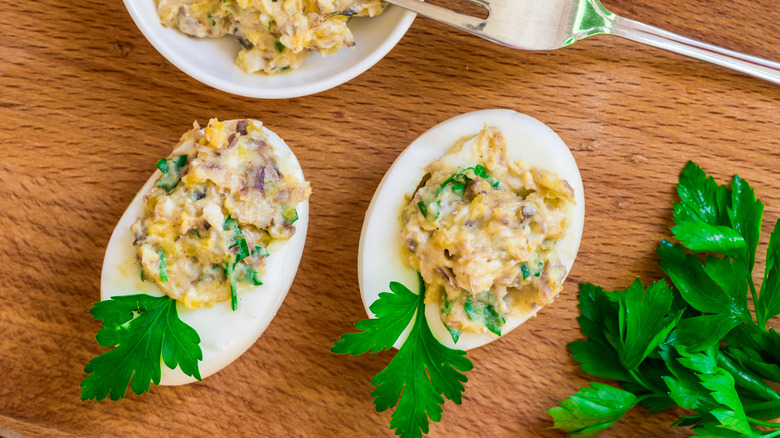The Centuries-Long Evolution Of Deviled Eggs
Unlike yesteryear's cold beef pudding and ambrosia salad, deviled eggs have never really gone out of style. Who could resist their creamy swirled centers peppered with spices, garnishes, and a touch of elegance? Any refreshment table can be both visually and substantively enhanced with the addition of these egg halves, and that's exactly what the Romans recognized more than two millennia ago (per NC Egg Association). Yes, deviled eggs have been around for centuries — it isn't just an oddity from the 1950s American table spread. Of course, we can only imagine that the Roman rendition of the deviled egg didn't have mayonnaise, but one could still recognize its similarities with what we have today.
Some would say that time is a flat circle, and, in a way, we can see evidence of that in the "innovative" preparations of deviled eggs today. Of course, the classic mustard, mayonnaise, and paprika combination will never go away. But we can be reminded of ancient Roman eggs when we have some variation of deviled eggs.
The Roman egg dish In Ovis Apalis
So what was this Roman version of deviled eggs? Well, as much as the structure of the dish was quite different from its modern version, the Roman egg dish was called In Ovis Apalis, an ancient appetizer that resembles the deviled egg today. According to Curious Cuisiniere, eggs were such a crucial part of the first course that there was a saying — "ab ovo usque ad mala" — which translates to "from eggs to apples," or from the beginning to the end of a meal.
By today's standards, it's hard to call these deviled eggs, since the only thing these have in common with modern recipes is the hard-boiled egg. PBS shares the recipe for the In Ovis Apalis, which means "boiled eggs with pine nut sauce." The pine nut sauce was made from soaked pine nuts, lovage or celery leaves, vinegar, honey, pepper, and garum or Roman fish sauce. The mixture was then poured over a plate of hard-boiled eggs and served only during the first part of a meal. You could imagine the sauce tasting like a salad vinaigrette, with its combination of vinegar, pepper, and honey. Though the serving technique differs from what we have today, the premise of the dish remains the same. As deviled eggs are only served as a canapé, In Ovis Apalis was also only a starter.
A millennium later in Andalusia, present-day Spain
The Ancient egg survived the fall of the Roman Empire and was found again in the Andalusian regions of Spain during the 13th century, per Visit Southern Spain. Not only did the hard-boiled egg evolve, but the garum as well, which became Spanish fish murri or brine, made as a paste or a sauce, according to this translation of Fadalat, a surviving medieval Muslim cooking manuscript. The Hispano-Muslims of this region were the first to stuff their hard-boiled eggs with a mixture of seasoning and crushed yolk. The Fandalat offers the original recipe for the stuffed egg: season the mashed yolks with salt and pepper, then combine with chopped cilantro, ginger, cinnamon, cloves, and murri (fish sauce).
The mixture is carefully placed into the hollowed center of the egg whites and then fastened back together with a sprig of oregano. After the egg is tied, it's coated in flour and fried in oil until golden brown. This preparation of the hard-boiled egg can be seen as the first real version of the deviled egg, but we cannot deny that the medieval Hispano-Muslims were inspired by the ancient In Ovis Apalis, or at least certain components of it, like garum fish sauce.
Stuffed eggs take over Europe
By the 15th century, stuffed eggs have spread throughout the continent of Europe. Like other dishes, the stuffed egg had tons of varieties that differed from region to region. Ancestral Findings found that Medieval stuffed egg recipes would include some combination of parsley, raisins, cheese, and herbs. After they were fried, some of these stuffed eggs were covered with powdered sugar, which could be an interesting twist to put on our deviled eggs today. After all, sweet and savory flavors are suitable for most hors d'oeuvres. This version of the stuffed egg was also served hot, rather than cold as it is today.
Medieval Cookery shares a translated recipe from the important medieval cookbook, Liber de Coquina, that includes marjoram, saffron, cloves, and cheese. Like the stuffed egg of Andalusia, this stuffed egg is fried in oil until brown. Funnily enough, these ingredients have made a comeback as of late. We can also find fresh herbs, cheese, and onions flavoring our deviled eggs, which were all ingredients used in medieval Europe.
Deviled eggs today
Before the deviled egg got its name, it was called many different things across countries: the French called them "oeufs mimosa" or mimosa eggs, while others called them dressed eggs, stuffed eggs, or salad eggs. The British were the first to describe anything spiced or fried as "deviled." Although this culinary term is now archaic, the deviled egg somehow stuck around. Of course, many resisted using this new name because they associated it with Satan, but Americans began to call this dish deviled eggs in the 18th and 19th centuries.
The modern version of the deviled egg, which uses mayonnaise as a binding agent for the egg yolk filling, was first found in the Boston Cooking-School Cookbook of 1896, per Grub Americana. However, this version of deviled eggs wasn't popularized until the 1940s, decades after commercialized mayonnaise was made available. Chronically Vintage surmises that deviled eggs really became popular in the States during the 1950s due to the advent of food preservation technology — yes, the refrigerator. It's unclear when deviled eggs became a cold dish, but the refrigerator most definitely contributed to how the dish is served today.
Now, we see all sorts of pickled vegetables, spices, and sauces being added to deviled eggs. A popular salty addition would be Worcestershire sauce, which vaguely resembles its forgotten ancestor, the Roman garum. Sure, deviled eggs had their periods of great popularity and obsolescence, but they are here to stay.




